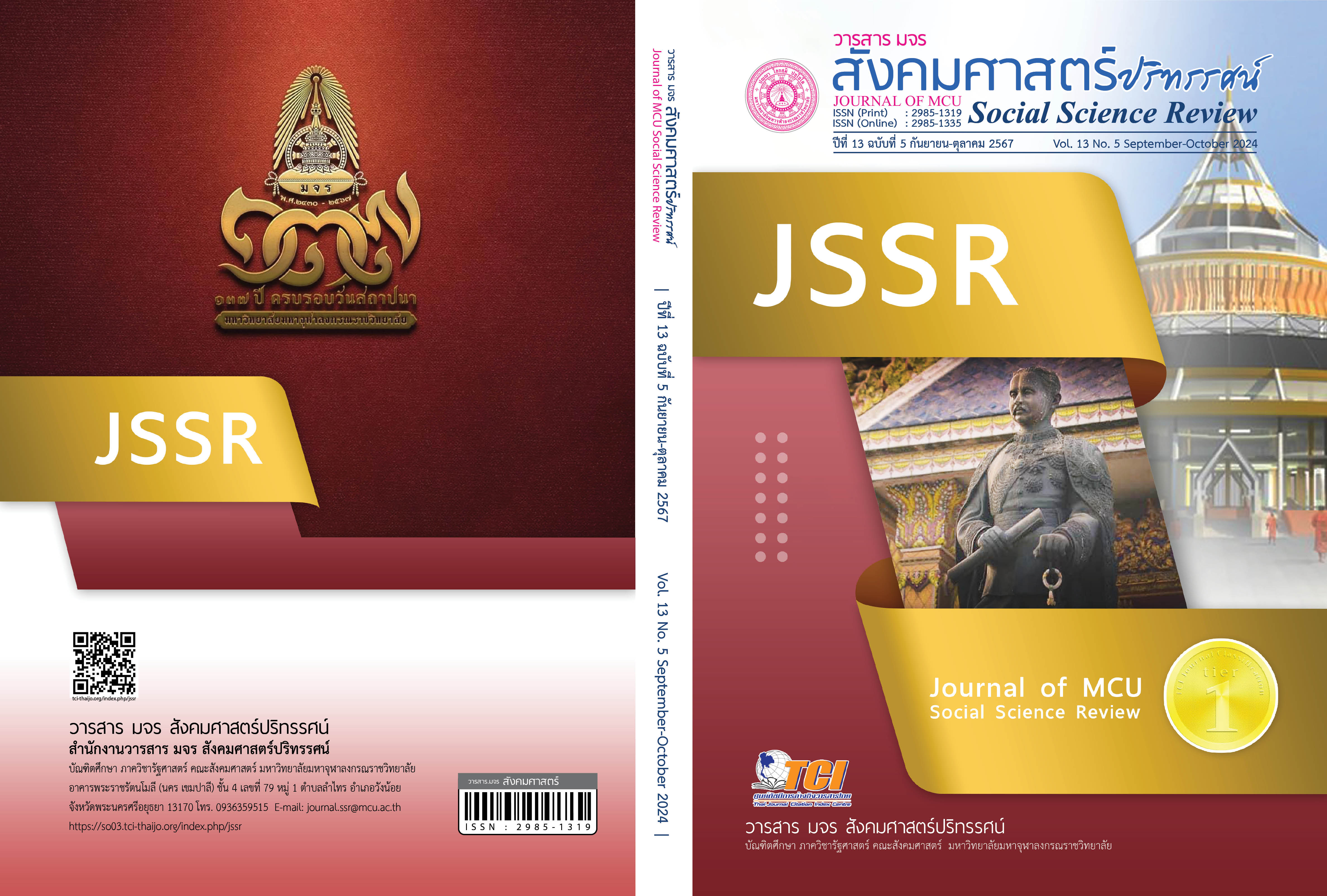การพัฒนาความสามารถในการพูดภาษาจีน โดยใช้การจัดการเรียนรู้ด้วยห้องเรียนกลับด้านร่วมกับเกมมิฟิเคชั่น สำหรับนักศึกษาระดับปริญญาตรี
คำสำคัญ:
ห้องเรียนกลับด้าน, เกมมิฟิเคชั่น, ความสามารถในการพูดภาษาจีน, ผลสัมฤทธิ์ทางการเรียนภาษาจีน, แรงจูงใจบทคัดย่อ
บทความการวิจัยครั้งนี้มีวัตถุประสงค์ 1. เปรียบเทียบความสามารถในการพูดภาษาจีน 2. เปรียบเทียบผลสัมฤทธิ์ทางการเรียนภาษาจีน และ 3. ศึกษาแรงจูงใจที่มีต่อการเรียนการพูดภาษาจีน กลุ่มตัวอย่าง คือ นักศึกษาระดับปริญญาตรีที่เรียนวิชาโทภาษาจีน คณะการท่องเที่ยวและการโรงแรม จำนวน 1 ห้อง 16 คน ได้มาจากการสุ่มแบบกลุ่ม (Cluster Random Sampling) โดยใช้วิธีการจับฉลาก เครื่องมือที่ใช้ในการวิจัย ได้แก่ 1. แผนการจัดการเรียนรู้ 2. แบบวัดความสามารถในการพูดภาษาจีน 3. แบบวัดผลสัมฤทธิ์ทางการเรียนภาษาจีน และ
4. แบบสอบถามแรงจูงใจที่มีต่อการเรียนการพูดภาษาจีน การวิเคราะห์ข้อมูลโดยใช้สถิติพื้นฐาน ร้อยละ ค่าเฉลี่ย ส่วนเบี่ยงเบนมาตรฐาน และสถิติตรวจสอบสมมุติฐาน โดยใช้ t-test for One Sample และ t-test for Dependent Samples
ผลการวิจัยพบว่า 1. นักศึกษามีความสามารถการพูดภาษาจีนสูงกว่าเกณฑ์กำหนดคะแนนร้อยละ 75 และมีนัยสำคัญทางสถิติที่ระดับ .05 (t=-75.582, p=.000) 2. นักศึกษามีผลสัมฤทธิ์ทางการเรียนภาษาจีน คะแนนเฉลี่ยหลังเรียนสูงกว่าก่อนเรียน อย่างมีนัยสำคัญทางสถิติที่ระดับ .05 (t=7.043*, p=.000) และ 3. นักศึกษามีแรงจูงใจต่อการเรียนการพูดภาษาจีน โดยภาพรวมอยู่ในระดับมาก
เอกสารอ้างอิง
เจริญ ภูวิจิตร. (2564). การจัดการเรียนรู้ทางออนไลน์อย่างมีประสิทธิภาพในยุคดิจิทัล. กรุงเทพฯ: สำนักงานปลัดกระทรวงศึกษาธิการ.
ธนภณ ไชยชนะ. (2557). การพัฒนาการเขียนพินอิน (สระลดรูป) ของนักเรียนชั้นประถมศึกษาปีที่ 4 โรงเรียนปรินส์รอยแยลส์วิทยาลัย (รายงานการวิจัย). เชียงใหม่: โรงเรียนปรินส์ รอยแยลส์วิทยาลัย.
บุญชม ศรีสะอาด. (2556). วิธีการทางสถิติสำหรับการวิจัย เล่ม 1 (พิมพ์ครั้งที่ 5). กรุงเทพฯ: สุวีริยาสาส์น.
เบญจภัค จงหมื่นไวย์ และคณะ(2561). เกมมิฟิเคชันเพื่อการเรียนรู้. วารสารวิชาการการประยุกต์ใช้เทคโนโลยีสารสนเทศ, 4(2), 34-43.
วรากร แซ่พุ่น และคณะ. (2560). การศึกษาสภาพและปัญหาการเรียนการสอนภาษาจีนของโรงเรียนมัธยมศึกษาในจังหวัดยะลา. วารสารมหาวิทยาลัยราชภัฏยะลา, 12(ฉบับพิเศษ). 126-136.
วิภาวรรณ สุนทรจามร. (2559). รายงานการวิจัยเพื่อพัฒนาการเรียนการสอนภาษาจีนในประเทศไทยสังเคราะห์ภาพรวม. กรุงเทพฯ: สำนักงานเลขาธิการสภาการศึกษา.
ศรินยา วงษ์ช่างหล่อและคณะ. (2561). ผลการจัดกิจกรรมการเรียนรู้แบบห้องเรียนกลับด้านที่มี ต่อผลสัมฤทธิ์ทางการเรียนและความรับผิดชอบในการเรียนหลักการใช้ภาษาไทยของนักเรียน ระดับชั้นมัธยมศึกษาตอนปลาย โรงเรียนสวนศรีวิทยา จังหวัดชุมพร. นนทบุรี: มหาวิทยาลัยสุโขทัยธรรมาธิราช.
สถานเอกอัครราชทูต ณ กรุงปักกิ่ง. (2562). ข้อมูลพื้นฐานเศรษฐกิจจีน. สืบค้น 1 มีนาคม 2565, จาก https://thaiembbeij.org/th/republic-of-china/investment/
สุวิมล มธุรส. (2564). การจัดการศึกษาในระบบออนไลน์ในยุค NEW NORMAL COVID-19. วารสารรัชต์ภาคย์, 15(40), 33-42.
หวัง หลิงเฉียน และไพทยา มีสัตย์ (2564). การพัฒนาความสามารถในการสื่อสารภาษาจีนโดยใช้วรรณกรรมเป็นฐานร่วมกับเทคนิค Think Pair Share สำหรับนักเรียนชั้นมัธยมศึกษาปีที่ 4. วารสารสหวิทยาการนวัตกรรมปริทรรศน์, 6(1), 33-47.
Alfares, N. (2017) Benefits and Difficulties of Learning in Group Work in EFL Classes in Saudi Arabia. English Language Teaching, 10(7), 247-256.
Anderson, L. W. & Krathwohl, D. R. (2001). A taxonomy for learning, teaching, and assessing: A revision of Bloom’s taxonomy of educational objectives. New York: Addison Wesley Longman.
Barkley, E. F. (2010). Student engagement techniques: A handbook for college faculty. San Francisco: Jossey-Bass.
Bashirath, M. (2011). Factor Effecting Students’ English-Speaking Skills. British Journal of Arts and Social Sciences, 2(1), 34-50.
Hanban. (2019). Confucius Institute. Retrieved March 20, 2022, from http://www.hanban.org/confuciusinstitutes/
Harris, D. P. (1990). Testing English as a second language. New York: McGraw-Hill Book.
Hilton, H. (2008). The link between vocabulary knowledge and spoken L2 fluency. Language Learning Journal, 36(2), 153-166.
Hoffman, L. (2015). Longitudinal analysis: Modeling within-person fluctuation and change. New York: Routledge.
Huang, B. & Hew, K. F. (2018). Implementing a theory-driven gamification model in higher education flipped courses: Effects on out-of-class activity completion and quality of artifacts. Computers & Education, 125(1), 254-272.
Huang, W. H. Y. & Soman, D. (2013). A practitioner's guide to gamification of education. Toronto: Rotman School of Management University of Toronto.
Khusnia, A. N. (2017). Politeness Strategies in EFL Classroom: Building Positive Values in Students. Advances in Social Science, Education and Humanities Research (ASSEHR), 109(1), 32-35.
Li, H. (2017). Feasibility research on the teaching mode of gamification flipped classroom in teaching Chinese as a foreign language. Chaina: Heilongjiang University.
Lin, S. F. (2021). China-Thailand Economic and Trade Relations in Perspectives of Thai Students Studying in China. Foreign Language Office of the Lower House of the Chinese National Assembly. Retrieved March 20, 2022, from https://shorturl.asia/2h5Qv
Marczewski, A. (2017). The ethics of gamification. XRDS, 24(1), 56-59.
Pérez, N. (2016). Effects of Tasks on Spoken Interaction and Motivation in English Language. Gist Education and Learning Research Journal, 13(1), 34-55.
Reng, S. J. (2018). Application of Game Teaching Method in Thailand's Junior High School in Chinese Teaching. Chaina: Yunnan University.
Tayler, A. (1986). Communicating. New Jersey: Prentice Hall International.
Topîrceanu, A. (2017). Gamified learning: A role-playing approach to increase student in-class motivation. Procedia Computer Science, 112(1), 41-50.
ดาวน์โหลด
เผยแพร่แล้ว
รูปแบบการอ้างอิง
ฉบับ
ประเภทบทความ
สัญญาอนุญาต
ลิขสิทธิ์ (c) 2024 วารสาร มจร สังคมศาสตร์ปริทรรศน์

อนุญาตภายใต้เงื่อนไข Creative Commons Attribution-NonCommercial-NoDerivatives 4.0 International License.
เพื่อให้เป็นไปตามกฎหมายลิขสิทธิ์ ผู้นิพนธ์ทุกท่านต้องลงลายมือชื่อในแบบฟอร์มใบมอบลิขสิทธิ์บทความให้แก่วารสารฯ พร้อมกับบทความต้นฉบับที่ได้แก้ไขครั้งสุดท้าย นอกจากนี้ ผู้นิพนธ์ทุกท่านต้องยืนยันว่าบทความต้นฉบับที่ส่งมาตีพิมพ์นั้น ได้ส่งมาตีพิมพ์เฉพาะในวารสาร มจร สังคมศาสตร์ปริทรรศน์ เพียงแห่งเดียวเท่านั้น หากมีการใช้ภาพหรือตารางหรือเนื้อหาอื่นๆ ของผู้นิพนธ์อื่นที่ปรากฏในสิ่งตีพิมพ์อื่นมาแล้ว ผู้นิพนธ์ต้องขออนุญาตเจ้าของลิขสิทธิ์ก่อน พร้อมทั้งแสดงหนังสือที่ได้รับการยินยอมต่อบรรณาธิการ ก่อนที่บทความจะได้รับการตีพิมพ์ หากไม่เป็นไปตามข้อกำหนดเบื้องต้น ทางวารสารจะถอดบทความของท่านออกโดยไม่มีข้อยกเว้นใดๆ ทั้งสิ้น





